Project Report: Stakeholder Management for Highway 99 Upgradation
VerifiedAdded on 2020/05/08
|20
|3711
|97
Report
AI Summary
This report provides a comprehensive analysis of stakeholder management within the Highway 99 upgradation project, also known as Burns Road, in Homer city. The project aims to alleviate traffic congestion and improve commercial transportation efficiency. The report outlines the project's scope, objectives, benefits (such as reduced traffic and increased commercial activity), and potential constraints, risks (environmental hazards, political issues), and assumptions. It identifies and analyzes key stakeholders, categorizing them based on their power and interest levels, and proposes a communication plan to ensure effective information flow. Requirement gathering tools, including surveys, questionnaires, and focus groups, were employed to gather data from residents, businesses, and other stakeholders. The analysis of gathered data revealed significant support for the project. The report concludes with solution strategies and recommendations for successful project execution, highlighting lessons learned and emphasizing the importance of stakeholder engagement and communication. The appendices include a questionnaire and further details on stakeholder management.

Running head: STAKEHOLDER MANAGEMENT IN PROJECT
STAKEHOLDER MANAGEMENT IN PROJECT
Name of the Student
Name of the University
Author note
STAKEHOLDER MANAGEMENT IN PROJECT
Name of the Student
Name of the University
Author note
Paraphrase This Document
Need a fresh take? Get an instant paraphrase of this document with our AI Paraphraser
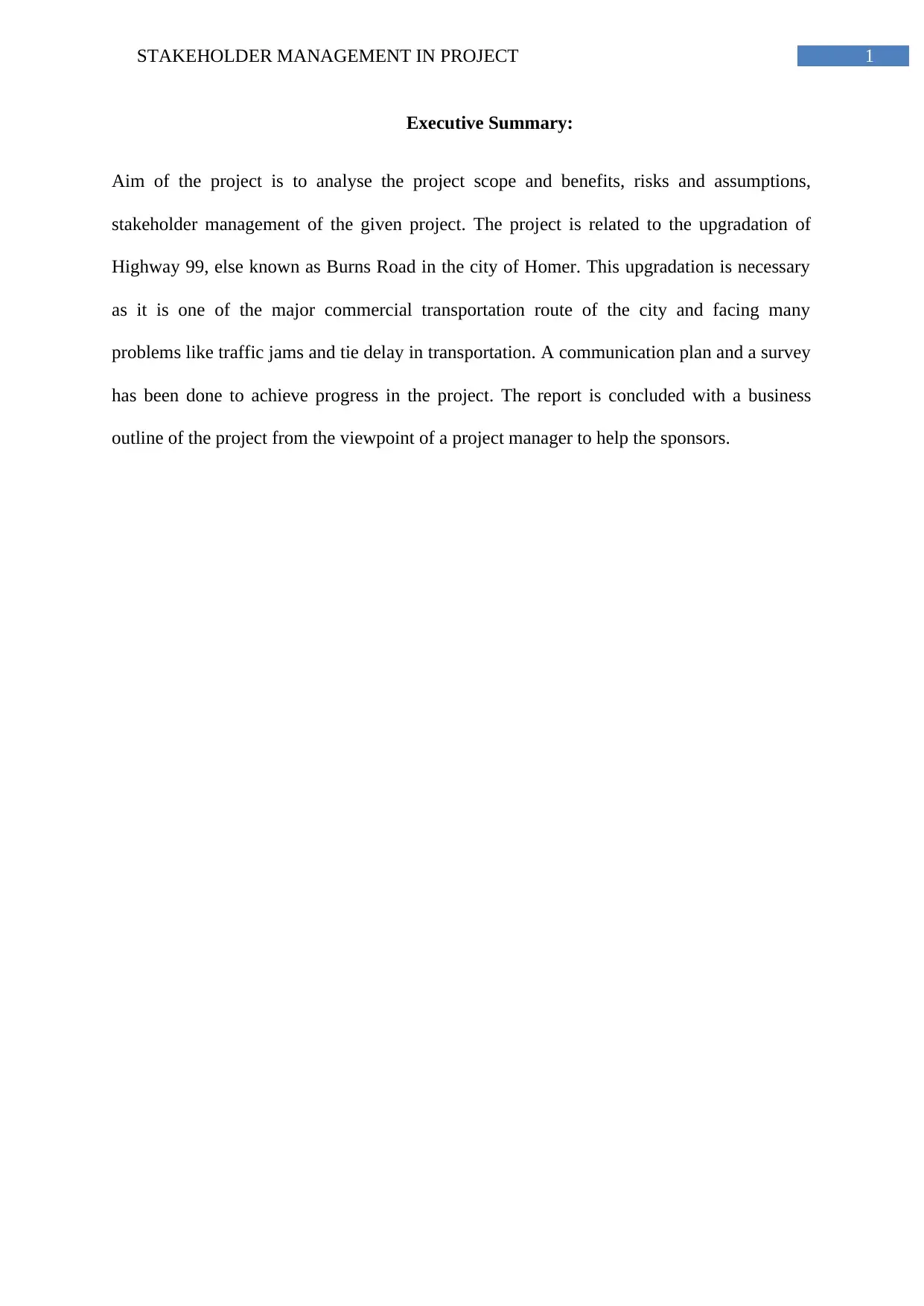
1STAKEHOLDER MANAGEMENT IN PROJECT
Executive Summary:
Aim of the project is to analyse the project scope and benefits, risks and assumptions,
stakeholder management of the given project. The project is related to the upgradation of
Highway 99, else known as Burns Road in the city of Homer. This upgradation is necessary
as it is one of the major commercial transportation route of the city and facing many
problems like traffic jams and tie delay in transportation. A communication plan and a survey
has been done to achieve progress in the project. The report is concluded with a business
outline of the project from the viewpoint of a project manager to help the sponsors.
Executive Summary:
Aim of the project is to analyse the project scope and benefits, risks and assumptions,
stakeholder management of the given project. The project is related to the upgradation of
Highway 99, else known as Burns Road in the city of Homer. This upgradation is necessary
as it is one of the major commercial transportation route of the city and facing many
problems like traffic jams and tie delay in transportation. A communication plan and a survey
has been done to achieve progress in the project. The report is concluded with a business
outline of the project from the viewpoint of a project manager to help the sponsors.
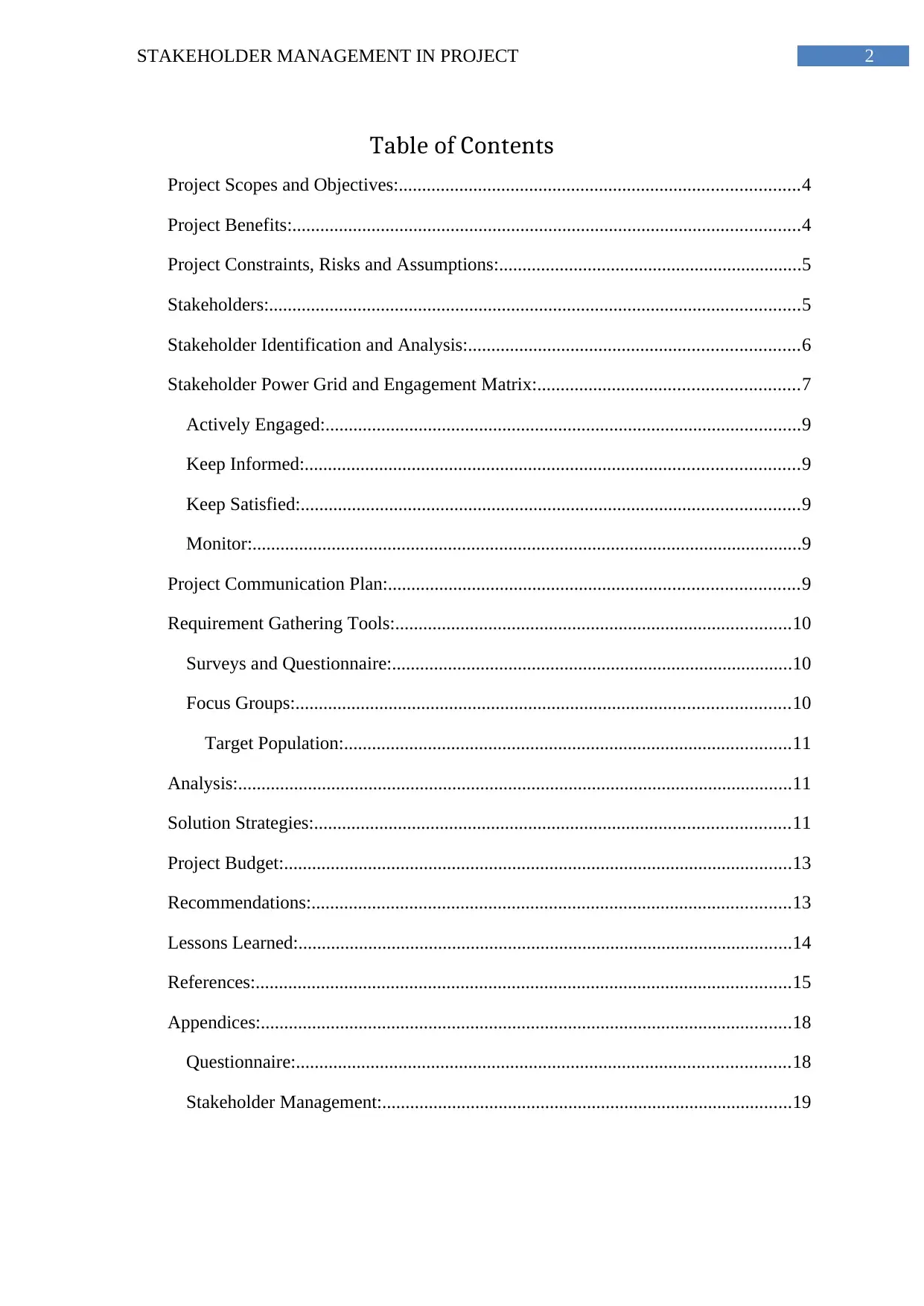
2STAKEHOLDER MANAGEMENT IN PROJECT
Table of Contents
Project Scopes and Objectives:......................................................................................4
Project Benefits:.............................................................................................................4
Project Constraints, Risks and Assumptions:.................................................................5
Stakeholders:..................................................................................................................5
Stakeholder Identification and Analysis:.......................................................................6
Stakeholder Power Grid and Engagement Matrix:........................................................7
Actively Engaged:......................................................................................................9
Keep Informed:..........................................................................................................9
Keep Satisfied:...........................................................................................................9
Monitor:......................................................................................................................9
Project Communication Plan:........................................................................................9
Requirement Gathering Tools:.....................................................................................10
Surveys and Questionnaire:......................................................................................10
Focus Groups:..........................................................................................................10
Target Population:................................................................................................11
Analysis:.......................................................................................................................11
Solution Strategies:......................................................................................................11
Project Budget:.............................................................................................................13
Recommendations:.......................................................................................................13
Lessons Learned:..........................................................................................................14
References:...................................................................................................................15
Appendices:..................................................................................................................18
Questionnaire:..........................................................................................................18
Stakeholder Management:........................................................................................19
Table of Contents
Project Scopes and Objectives:......................................................................................4
Project Benefits:.............................................................................................................4
Project Constraints, Risks and Assumptions:.................................................................5
Stakeholders:..................................................................................................................5
Stakeholder Identification and Analysis:.......................................................................6
Stakeholder Power Grid and Engagement Matrix:........................................................7
Actively Engaged:......................................................................................................9
Keep Informed:..........................................................................................................9
Keep Satisfied:...........................................................................................................9
Monitor:......................................................................................................................9
Project Communication Plan:........................................................................................9
Requirement Gathering Tools:.....................................................................................10
Surveys and Questionnaire:......................................................................................10
Focus Groups:..........................................................................................................10
Target Population:................................................................................................11
Analysis:.......................................................................................................................11
Solution Strategies:......................................................................................................11
Project Budget:.............................................................................................................13
Recommendations:.......................................................................................................13
Lessons Learned:..........................................................................................................14
References:...................................................................................................................15
Appendices:..................................................................................................................18
Questionnaire:..........................................................................................................18
Stakeholder Management:........................................................................................19
⊘ This is a preview!⊘
Do you want full access?
Subscribe today to unlock all pages.

Trusted by 1+ million students worldwide
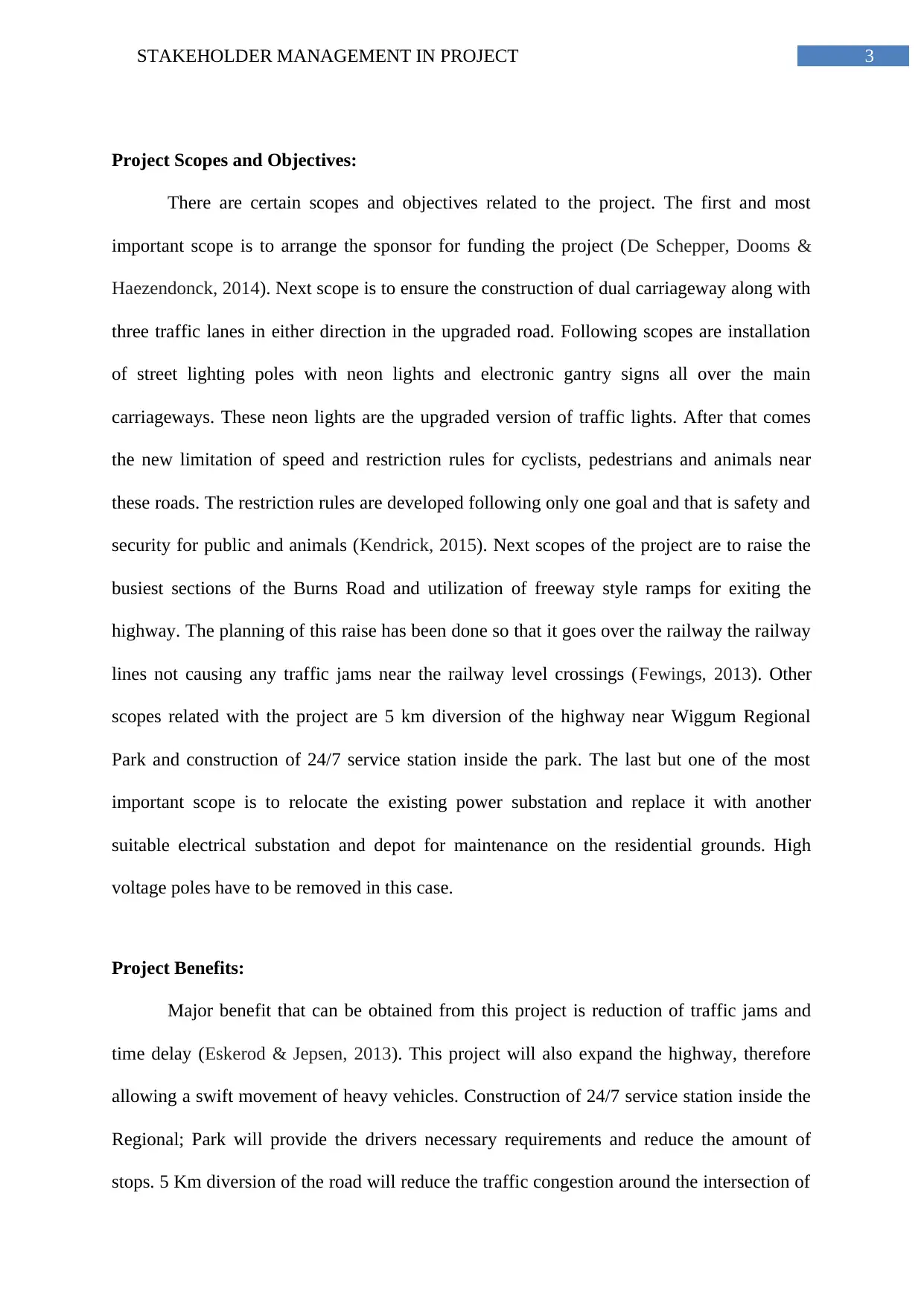
3STAKEHOLDER MANAGEMENT IN PROJECT
Project Scopes and Objectives:
There are certain scopes and objectives related to the project. The first and most
important scope is to arrange the sponsor for funding the project (De Schepper, Dooms &
Haezendonck, 2014). Next scope is to ensure the construction of dual carriageway along with
three traffic lanes in either direction in the upgraded road. Following scopes are installation
of street lighting poles with neon lights and electronic gantry signs all over the main
carriageways. These neon lights are the upgraded version of traffic lights. After that comes
the new limitation of speed and restriction rules for cyclists, pedestrians and animals near
these roads. The restriction rules are developed following only one goal and that is safety and
security for public and animals (Kendrick, 2015). Next scopes of the project are to raise the
busiest sections of the Burns Road and utilization of freeway style ramps for exiting the
highway. The planning of this raise has been done so that it goes over the railway the railway
lines not causing any traffic jams near the railway level crossings (Fewings, 2013). Other
scopes related with the project are 5 km diversion of the highway near Wiggum Regional
Park and construction of 24/7 service station inside the park. The last but one of the most
important scope is to relocate the existing power substation and replace it with another
suitable electrical substation and depot for maintenance on the residential grounds. High
voltage poles have to be removed in this case.
Project Benefits:
Major benefit that can be obtained from this project is reduction of traffic jams and
time delay (Eskerod & Jepsen, 2013). This project will also expand the highway, therefore
allowing a swift movement of heavy vehicles. Construction of 24/7 service station inside the
Regional; Park will provide the drivers necessary requirements and reduce the amount of
stops. 5 Km diversion of the road will reduce the traffic congestion around the intersection of
Project Scopes and Objectives:
There are certain scopes and objectives related to the project. The first and most
important scope is to arrange the sponsor for funding the project (De Schepper, Dooms &
Haezendonck, 2014). Next scope is to ensure the construction of dual carriageway along with
three traffic lanes in either direction in the upgraded road. Following scopes are installation
of street lighting poles with neon lights and electronic gantry signs all over the main
carriageways. These neon lights are the upgraded version of traffic lights. After that comes
the new limitation of speed and restriction rules for cyclists, pedestrians and animals near
these roads. The restriction rules are developed following only one goal and that is safety and
security for public and animals (Kendrick, 2015). Next scopes of the project are to raise the
busiest sections of the Burns Road and utilization of freeway style ramps for exiting the
highway. The planning of this raise has been done so that it goes over the railway the railway
lines not causing any traffic jams near the railway level crossings (Fewings, 2013). Other
scopes related with the project are 5 km diversion of the highway near Wiggum Regional
Park and construction of 24/7 service station inside the park. The last but one of the most
important scope is to relocate the existing power substation and replace it with another
suitable electrical substation and depot for maintenance on the residential grounds. High
voltage poles have to be removed in this case.
Project Benefits:
Major benefit that can be obtained from this project is reduction of traffic jams and
time delay (Eskerod & Jepsen, 2013). This project will also expand the highway, therefore
allowing a swift movement of heavy vehicles. Construction of 24/7 service station inside the
Regional; Park will provide the drivers necessary requirements and reduce the amount of
stops. 5 Km diversion of the road will reduce the traffic congestion around the intersection of
Paraphrase This Document
Need a fresh take? Get an instant paraphrase of this document with our AI Paraphraser
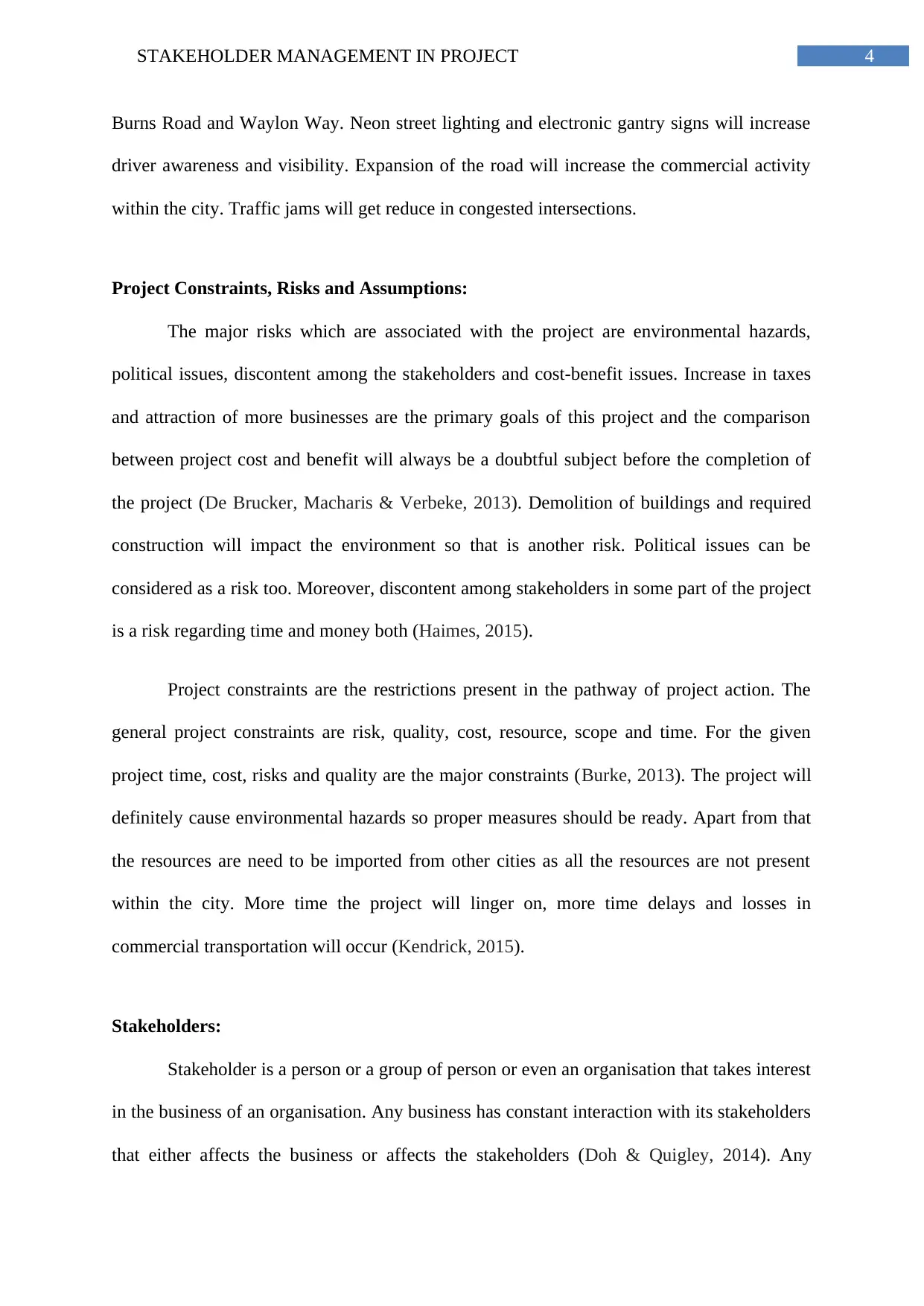
4STAKEHOLDER MANAGEMENT IN PROJECT
Burns Road and Waylon Way. Neon street lighting and electronic gantry signs will increase
driver awareness and visibility. Expansion of the road will increase the commercial activity
within the city. Traffic jams will get reduce in congested intersections.
Project Constraints, Risks and Assumptions:
The major risks which are associated with the project are environmental hazards,
political issues, discontent among the stakeholders and cost-benefit issues. Increase in taxes
and attraction of more businesses are the primary goals of this project and the comparison
between project cost and benefit will always be a doubtful subject before the completion of
the project (De Brucker, Macharis & Verbeke, 2013). Demolition of buildings and required
construction will impact the environment so that is another risk. Political issues can be
considered as a risk too. Moreover, discontent among stakeholders in some part of the project
is a risk regarding time and money both (Haimes, 2015).
Project constraints are the restrictions present in the pathway of project action. The
general project constraints are risk, quality, cost, resource, scope and time. For the given
project time, cost, risks and quality are the major constraints (Burke, 2013). The project will
definitely cause environmental hazards so proper measures should be ready. Apart from that
the resources are need to be imported from other cities as all the resources are not present
within the city. More time the project will linger on, more time delays and losses in
commercial transportation will occur (Kendrick, 2015).
Stakeholders:
Stakeholder is a person or a group of person or even an organisation that takes interest
in the business of an organisation. Any business has constant interaction with its stakeholders
that either affects the business or affects the stakeholders (Doh & Quigley, 2014). Any
Burns Road and Waylon Way. Neon street lighting and electronic gantry signs will increase
driver awareness and visibility. Expansion of the road will increase the commercial activity
within the city. Traffic jams will get reduce in congested intersections.
Project Constraints, Risks and Assumptions:
The major risks which are associated with the project are environmental hazards,
political issues, discontent among the stakeholders and cost-benefit issues. Increase in taxes
and attraction of more businesses are the primary goals of this project and the comparison
between project cost and benefit will always be a doubtful subject before the completion of
the project (De Brucker, Macharis & Verbeke, 2013). Demolition of buildings and required
construction will impact the environment so that is another risk. Political issues can be
considered as a risk too. Moreover, discontent among stakeholders in some part of the project
is a risk regarding time and money both (Haimes, 2015).
Project constraints are the restrictions present in the pathway of project action. The
general project constraints are risk, quality, cost, resource, scope and time. For the given
project time, cost, risks and quality are the major constraints (Burke, 2013). The project will
definitely cause environmental hazards so proper measures should be ready. Apart from that
the resources are need to be imported from other cities as all the resources are not present
within the city. More time the project will linger on, more time delays and losses in
commercial transportation will occur (Kendrick, 2015).
Stakeholders:
Stakeholder is a person or a group of person or even an organisation that takes interest
in the business of an organisation. Any business has constant interaction with its stakeholders
that either affects the business or affects the stakeholders (Doh & Quigley, 2014). Any
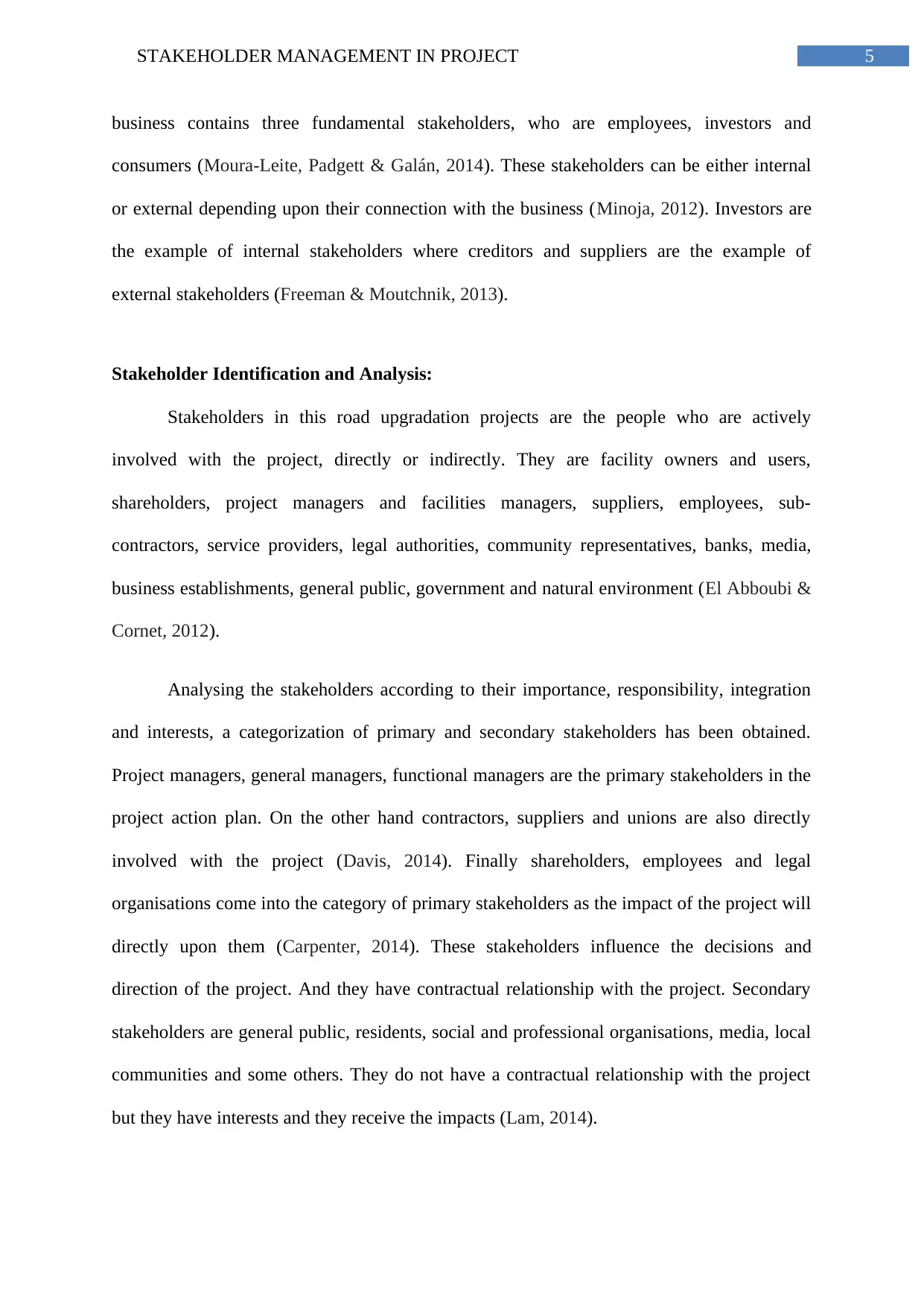
5STAKEHOLDER MANAGEMENT IN PROJECT
business contains three fundamental stakeholders, who are employees, investors and
consumers (Moura-Leite, Padgett & Galán, 2014). These stakeholders can be either internal
or external depending upon their connection with the business (Minoja, 2012). Investors are
the example of internal stakeholders where creditors and suppliers are the example of
external stakeholders (Freeman & Moutchnik, 2013).
Stakeholder Identification and Analysis:
Stakeholders in this road upgradation projects are the people who are actively
involved with the project, directly or indirectly. They are facility owners and users,
shareholders, project managers and facilities managers, suppliers, employees, sub-
contractors, service providers, legal authorities, community representatives, banks, media,
business establishments, general public, government and natural environment (El Abboubi &
Cornet, 2012).
Analysing the stakeholders according to their importance, responsibility, integration
and interests, a categorization of primary and secondary stakeholders has been obtained.
Project managers, general managers, functional managers are the primary stakeholders in the
project action plan. On the other hand contractors, suppliers and unions are also directly
involved with the project (Davis, 2014). Finally shareholders, employees and legal
organisations come into the category of primary stakeholders as the impact of the project will
directly upon them (Carpenter, 2014). These stakeholders influence the decisions and
direction of the project. And they have contractual relationship with the project. Secondary
stakeholders are general public, residents, social and professional organisations, media, local
communities and some others. They do not have a contractual relationship with the project
but they have interests and they receive the impacts (Lam, 2014).
business contains three fundamental stakeholders, who are employees, investors and
consumers (Moura-Leite, Padgett & Galán, 2014). These stakeholders can be either internal
or external depending upon their connection with the business (Minoja, 2012). Investors are
the example of internal stakeholders where creditors and suppliers are the example of
external stakeholders (Freeman & Moutchnik, 2013).
Stakeholder Identification and Analysis:
Stakeholders in this road upgradation projects are the people who are actively
involved with the project, directly or indirectly. They are facility owners and users,
shareholders, project managers and facilities managers, suppliers, employees, sub-
contractors, service providers, legal authorities, community representatives, banks, media,
business establishments, general public, government and natural environment (El Abboubi &
Cornet, 2012).
Analysing the stakeholders according to their importance, responsibility, integration
and interests, a categorization of primary and secondary stakeholders has been obtained.
Project managers, general managers, functional managers are the primary stakeholders in the
project action plan. On the other hand contractors, suppliers and unions are also directly
involved with the project (Davis, 2014). Finally shareholders, employees and legal
organisations come into the category of primary stakeholders as the impact of the project will
directly upon them (Carpenter, 2014). These stakeholders influence the decisions and
direction of the project. And they have contractual relationship with the project. Secondary
stakeholders are general public, residents, social and professional organisations, media, local
communities and some others. They do not have a contractual relationship with the project
but they have interests and they receive the impacts (Lam, 2014).
⊘ This is a preview!⊘
Do you want full access?
Subscribe today to unlock all pages.

Trusted by 1+ million students worldwide
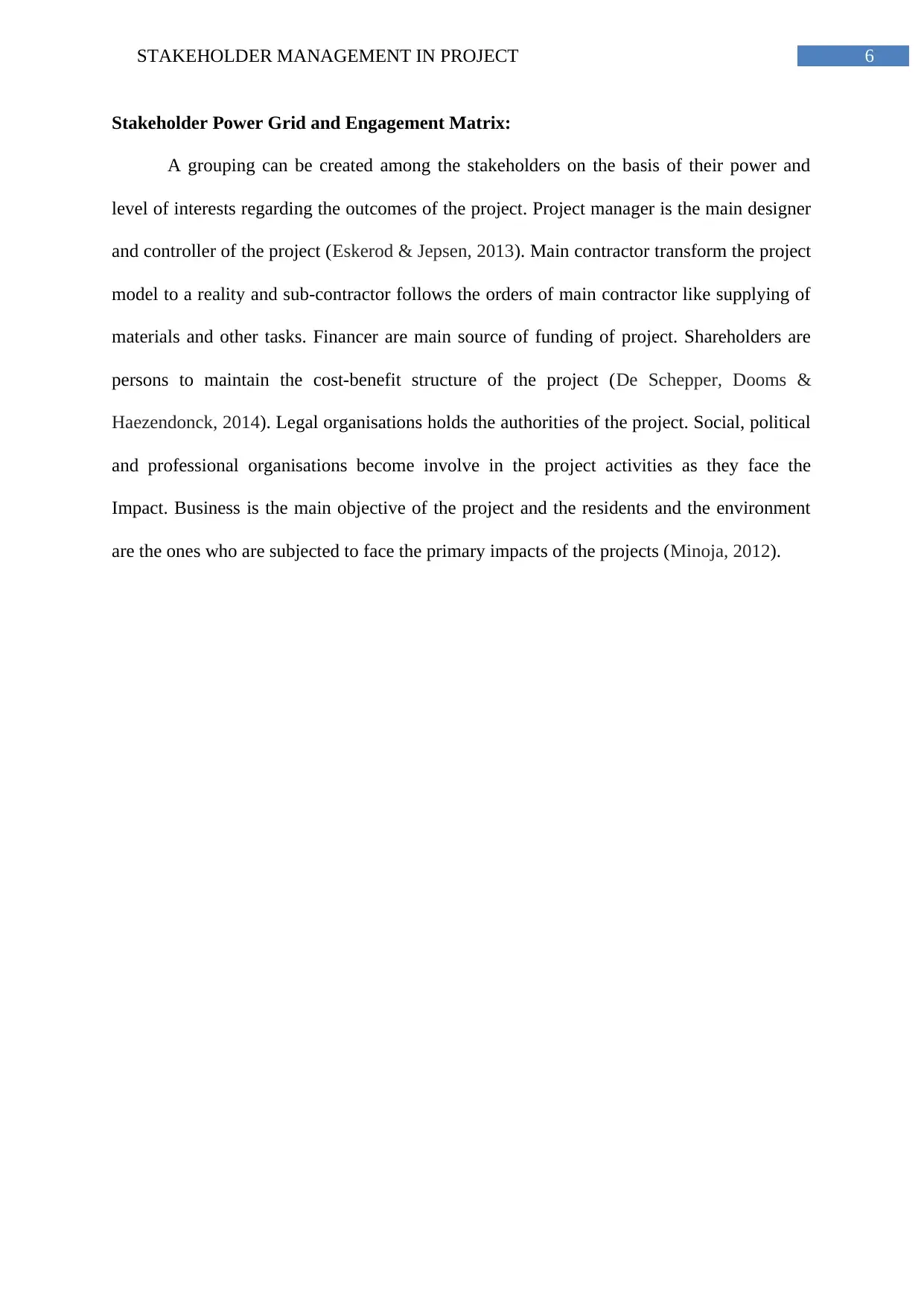
6STAKEHOLDER MANAGEMENT IN PROJECT
Stakeholder Power Grid and Engagement Matrix:
A grouping can be created among the stakeholders on the basis of their power and
level of interests regarding the outcomes of the project. Project manager is the main designer
and controller of the project (Eskerod & Jepsen, 2013). Main contractor transform the project
model to a reality and sub-contractor follows the orders of main contractor like supplying of
materials and other tasks. Financer are main source of funding of project. Shareholders are
persons to maintain the cost-benefit structure of the project (De Schepper, Dooms &
Haezendonck, 2014). Legal organisations holds the authorities of the project. Social, political
and professional organisations become involve in the project activities as they face the
Impact. Business is the main objective of the project and the residents and the environment
are the ones who are subjected to face the primary impacts of the projects (Minoja, 2012).
Stakeholder Power Grid and Engagement Matrix:
A grouping can be created among the stakeholders on the basis of their power and
level of interests regarding the outcomes of the project. Project manager is the main designer
and controller of the project (Eskerod & Jepsen, 2013). Main contractor transform the project
model to a reality and sub-contractor follows the orders of main contractor like supplying of
materials and other tasks. Financer are main source of funding of project. Shareholders are
persons to maintain the cost-benefit structure of the project (De Schepper, Dooms &
Haezendonck, 2014). Legal organisations holds the authorities of the project. Social, political
and professional organisations become involve in the project activities as they face the
Impact. Business is the main objective of the project and the residents and the environment
are the ones who are subjected to face the primary impacts of the projects (Minoja, 2012).
Paraphrase This Document
Need a fresh take? Get an instant paraphrase of this document with our AI Paraphraser
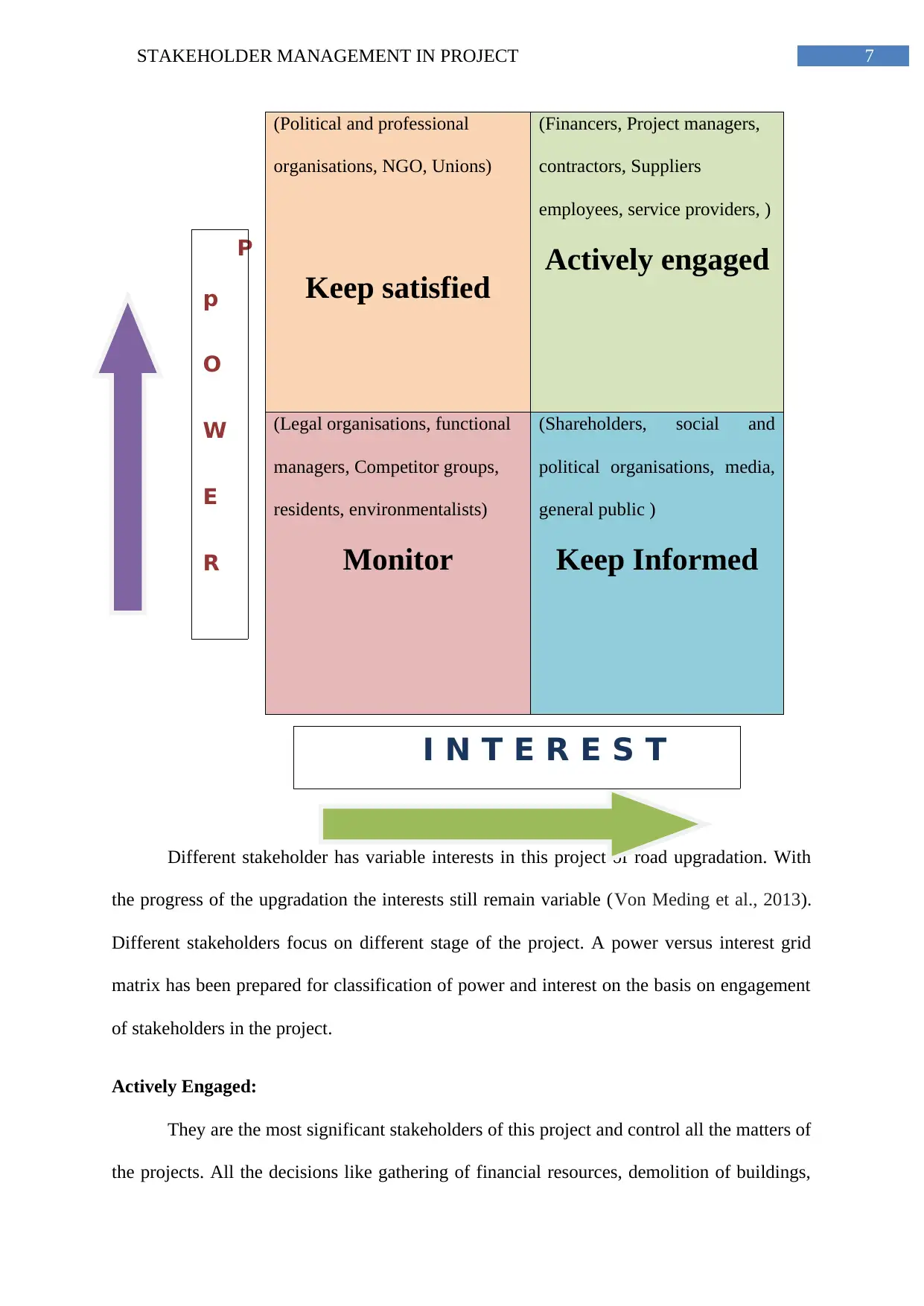
7STAKEHOLDER MANAGEMENT IN PROJECT
(Political and professional
organisations, NGO, Unions)
Keep satisfied
(Financers, Project managers,
contractors, Suppliers
employees, service providers, )
Actively engaged
(Legal organisations, functional
managers, Competitor groups,
residents, environmentalists)
Monitor
(Shareholders, social and
political organisations, media,
general public )
Keep Informed
Different stakeholder has variable interests in this project of road upgradation. With
the progress of the upgradation the interests still remain variable (Von Meding et al., 2013).
Different stakeholders focus on different stage of the project. A power versus interest grid
matrix has been prepared for classification of power and interest on the basis on engagement
of stakeholders in the project.
Actively Engaged:
They are the most significant stakeholders of this project and control all the matters of
the projects. All the decisions like gathering of financial resources, demolition of buildings,
P
p
O
W
E
R
I N T E R E S T
(Political and professional
organisations, NGO, Unions)
Keep satisfied
(Financers, Project managers,
contractors, Suppliers
employees, service providers, )
Actively engaged
(Legal organisations, functional
managers, Competitor groups,
residents, environmentalists)
Monitor
(Shareholders, social and
political organisations, media,
general public )
Keep Informed
Different stakeholder has variable interests in this project of road upgradation. With
the progress of the upgradation the interests still remain variable (Von Meding et al., 2013).
Different stakeholders focus on different stage of the project. A power versus interest grid
matrix has been prepared for classification of power and interest on the basis on engagement
of stakeholders in the project.
Actively Engaged:
They are the most significant stakeholders of this project and control all the matters of
the projects. All the decisions like gathering of financial resources, demolition of buildings,
P
p
O
W
E
R
I N T E R E S T
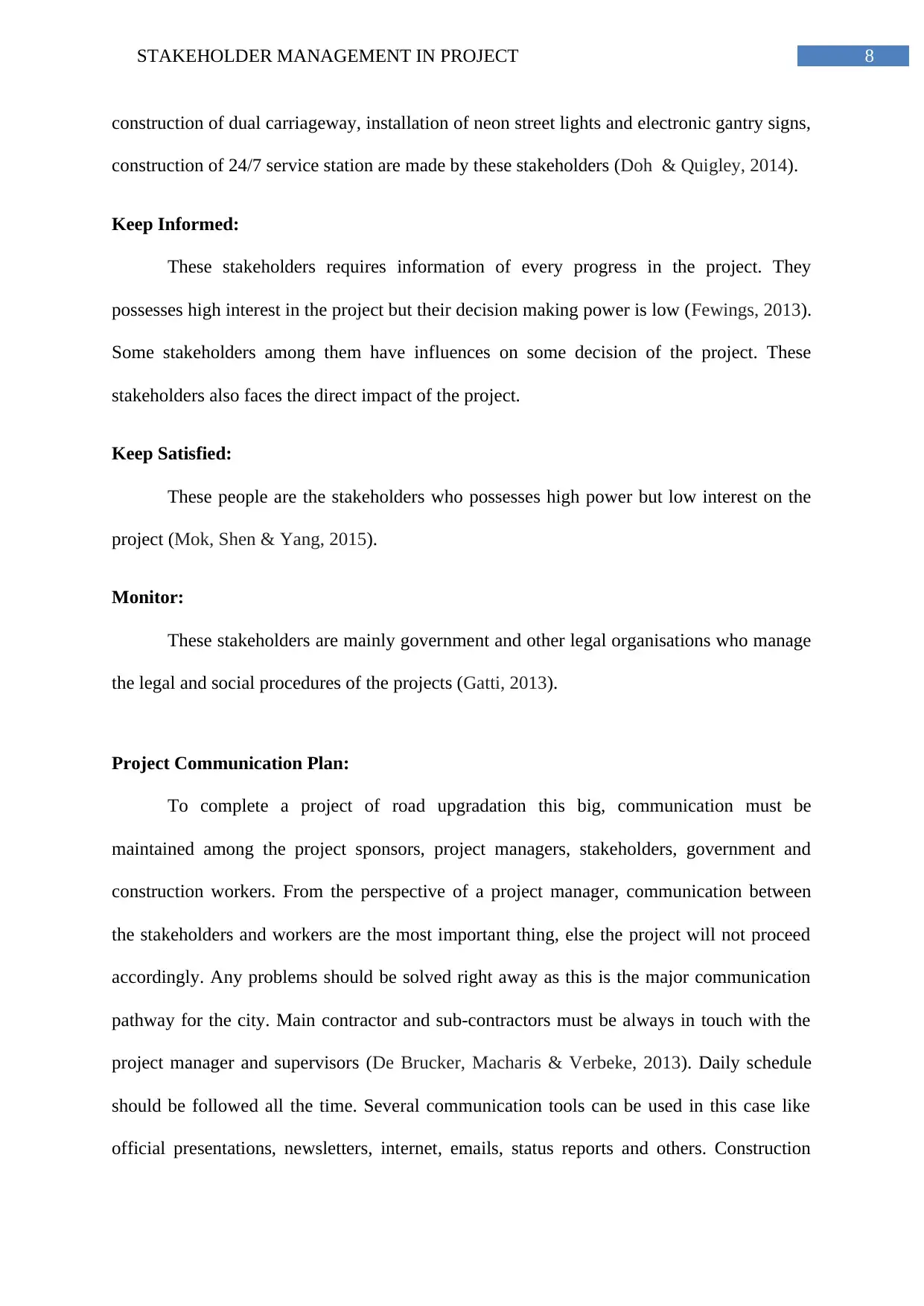
8STAKEHOLDER MANAGEMENT IN PROJECT
construction of dual carriageway, installation of neon street lights and electronic gantry signs,
construction of 24/7 service station are made by these stakeholders (Doh & Quigley, 2014).
Keep Informed:
These stakeholders requires information of every progress in the project. They
possesses high interest in the project but their decision making power is low (Fewings, 2013).
Some stakeholders among them have influences on some decision of the project. These
stakeholders also faces the direct impact of the project.
Keep Satisfied:
These people are the stakeholders who possesses high power but low interest on the
project (Mok, Shen & Yang, 2015).
Monitor:
These stakeholders are mainly government and other legal organisations who manage
the legal and social procedures of the projects (Gatti, 2013).
Project Communication Plan:
To complete a project of road upgradation this big, communication must be
maintained among the project sponsors, project managers, stakeholders, government and
construction workers. From the perspective of a project manager, communication between
the stakeholders and workers are the most important thing, else the project will not proceed
accordingly. Any problems should be solved right away as this is the major communication
pathway for the city. Main contractor and sub-contractors must be always in touch with the
project manager and supervisors (De Brucker, Macharis & Verbeke, 2013). Daily schedule
should be followed all the time. Several communication tools can be used in this case like
official presentations, newsletters, internet, emails, status reports and others. Construction
construction of dual carriageway, installation of neon street lights and electronic gantry signs,
construction of 24/7 service station are made by these stakeholders (Doh & Quigley, 2014).
Keep Informed:
These stakeholders requires information of every progress in the project. They
possesses high interest in the project but their decision making power is low (Fewings, 2013).
Some stakeholders among them have influences on some decision of the project. These
stakeholders also faces the direct impact of the project.
Keep Satisfied:
These people are the stakeholders who possesses high power but low interest on the
project (Mok, Shen & Yang, 2015).
Monitor:
These stakeholders are mainly government and other legal organisations who manage
the legal and social procedures of the projects (Gatti, 2013).
Project Communication Plan:
To complete a project of road upgradation this big, communication must be
maintained among the project sponsors, project managers, stakeholders, government and
construction workers. From the perspective of a project manager, communication between
the stakeholders and workers are the most important thing, else the project will not proceed
accordingly. Any problems should be solved right away as this is the major communication
pathway for the city. Main contractor and sub-contractors must be always in touch with the
project manager and supervisors (De Brucker, Macharis & Verbeke, 2013). Daily schedule
should be followed all the time. Several communication tools can be used in this case like
official presentations, newsletters, internet, emails, status reports and others. Construction
⊘ This is a preview!⊘
Do you want full access?
Subscribe today to unlock all pages.

Trusted by 1+ million students worldwide
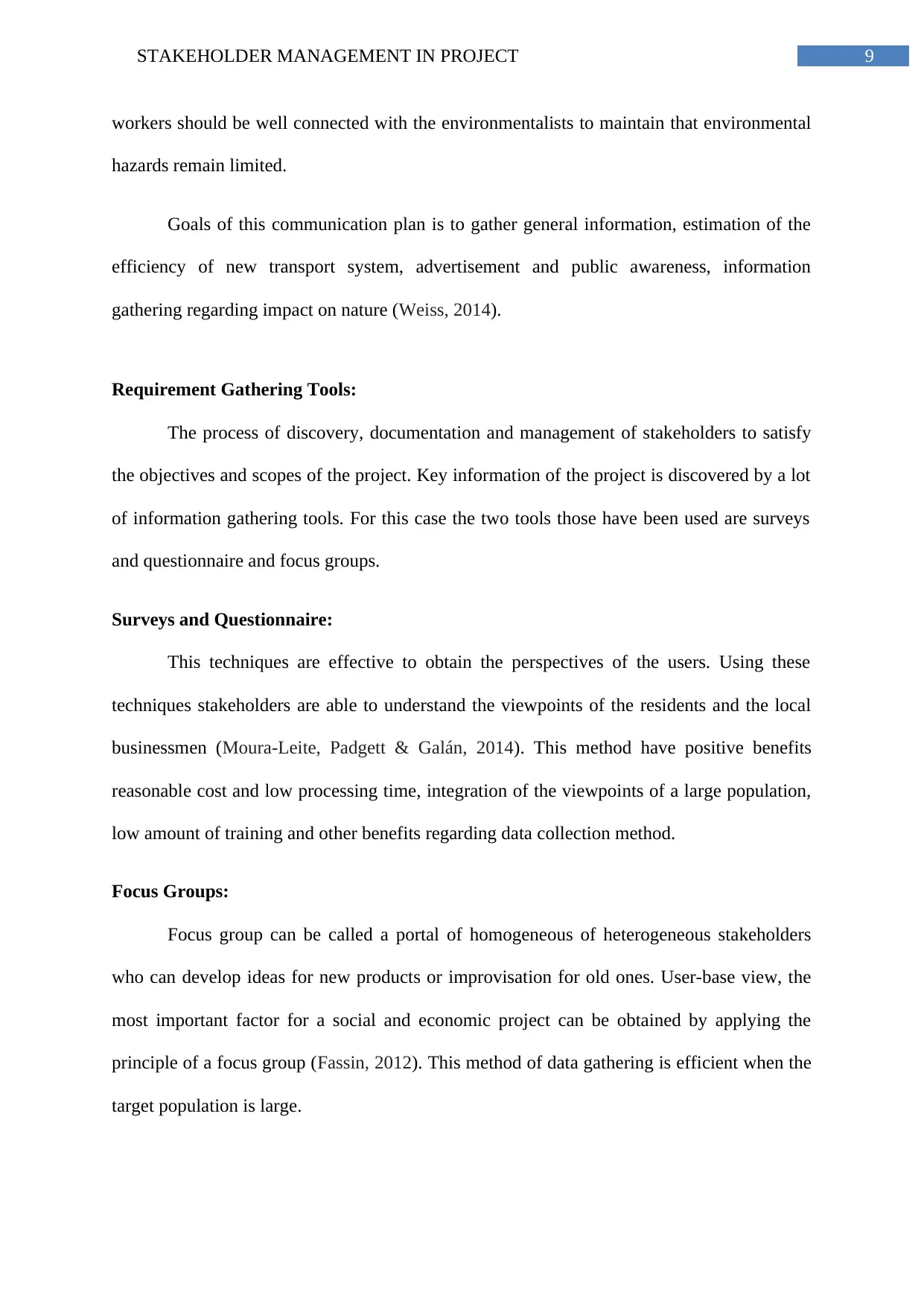
9STAKEHOLDER MANAGEMENT IN PROJECT
workers should be well connected with the environmentalists to maintain that environmental
hazards remain limited.
Goals of this communication plan is to gather general information, estimation of the
efficiency of new transport system, advertisement and public awareness, information
gathering regarding impact on nature (Weiss, 2014).
Requirement Gathering Tools:
The process of discovery, documentation and management of stakeholders to satisfy
the objectives and scopes of the project. Key information of the project is discovered by a lot
of information gathering tools. For this case the two tools those have been used are surveys
and questionnaire and focus groups.
Surveys and Questionnaire:
This techniques are effective to obtain the perspectives of the users. Using these
techniques stakeholders are able to understand the viewpoints of the residents and the local
businessmen (Moura-Leite, Padgett & Galán, 2014). This method have positive benefits
reasonable cost and low processing time, integration of the viewpoints of a large population,
low amount of training and other benefits regarding data collection method.
Focus Groups:
Focus group can be called a portal of homogeneous of heterogeneous stakeholders
who can develop ideas for new products or improvisation for old ones. User-base view, the
most important factor for a social and economic project can be obtained by applying the
principle of a focus group (Fassin, 2012). This method of data gathering is efficient when the
target population is large.
workers should be well connected with the environmentalists to maintain that environmental
hazards remain limited.
Goals of this communication plan is to gather general information, estimation of the
efficiency of new transport system, advertisement and public awareness, information
gathering regarding impact on nature (Weiss, 2014).
Requirement Gathering Tools:
The process of discovery, documentation and management of stakeholders to satisfy
the objectives and scopes of the project. Key information of the project is discovered by a lot
of information gathering tools. For this case the two tools those have been used are surveys
and questionnaire and focus groups.
Surveys and Questionnaire:
This techniques are effective to obtain the perspectives of the users. Using these
techniques stakeholders are able to understand the viewpoints of the residents and the local
businessmen (Moura-Leite, Padgett & Galán, 2014). This method have positive benefits
reasonable cost and low processing time, integration of the viewpoints of a large population,
low amount of training and other benefits regarding data collection method.
Focus Groups:
Focus group can be called a portal of homogeneous of heterogeneous stakeholders
who can develop ideas for new products or improvisation for old ones. User-base view, the
most important factor for a social and economic project can be obtained by applying the
principle of a focus group (Fassin, 2012). This method of data gathering is efficient when the
target population is large.
Paraphrase This Document
Need a fresh take? Get an instant paraphrase of this document with our AI Paraphraser
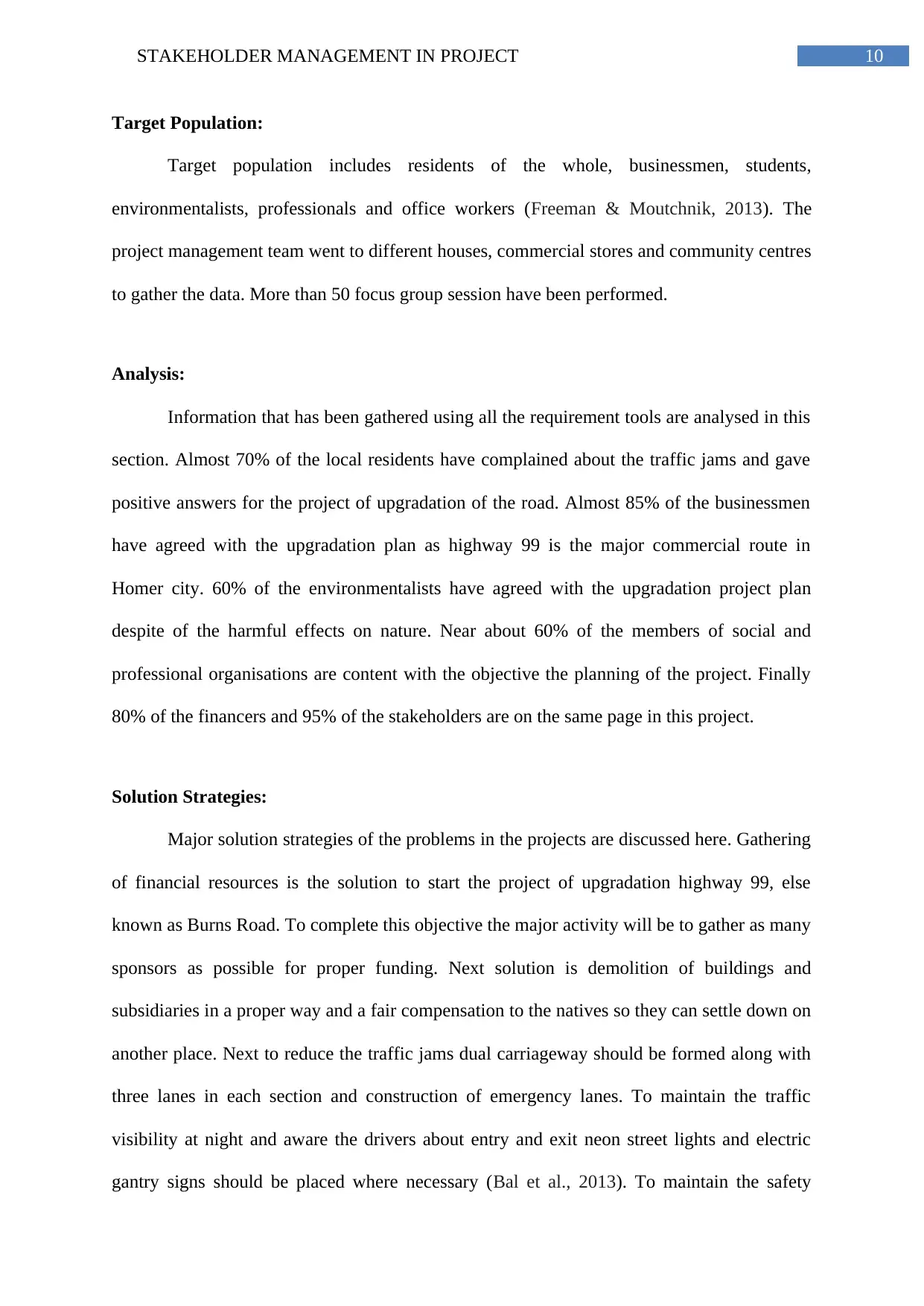
10STAKEHOLDER MANAGEMENT IN PROJECT
Target Population:
Target population includes residents of the whole, businessmen, students,
environmentalists, professionals and office workers (Freeman & Moutchnik, 2013). The
project management team went to different houses, commercial stores and community centres
to gather the data. More than 50 focus group session have been performed.
Analysis:
Information that has been gathered using all the requirement tools are analysed in this
section. Almost 70% of the local residents have complained about the traffic jams and gave
positive answers for the project of upgradation of the road. Almost 85% of the businessmen
have agreed with the upgradation plan as highway 99 is the major commercial route in
Homer city. 60% of the environmentalists have agreed with the upgradation project plan
despite of the harmful effects on nature. Near about 60% of the members of social and
professional organisations are content with the objective the planning of the project. Finally
80% of the financers and 95% of the stakeholders are on the same page in this project.
Solution Strategies:
Major solution strategies of the problems in the projects are discussed here. Gathering
of financial resources is the solution to start the project of upgradation highway 99, else
known as Burns Road. To complete this objective the major activity will be to gather as many
sponsors as possible for proper funding. Next solution is demolition of buildings and
subsidiaries in a proper way and a fair compensation to the natives so they can settle down on
another place. Next to reduce the traffic jams dual carriageway should be formed along with
three lanes in each section and construction of emergency lanes. To maintain the traffic
visibility at night and aware the drivers about entry and exit neon street lights and electric
gantry signs should be placed where necessary (Bal et al., 2013). To maintain the safety
Target Population:
Target population includes residents of the whole, businessmen, students,
environmentalists, professionals and office workers (Freeman & Moutchnik, 2013). The
project management team went to different houses, commercial stores and community centres
to gather the data. More than 50 focus group session have been performed.
Analysis:
Information that has been gathered using all the requirement tools are analysed in this
section. Almost 70% of the local residents have complained about the traffic jams and gave
positive answers for the project of upgradation of the road. Almost 85% of the businessmen
have agreed with the upgradation plan as highway 99 is the major commercial route in
Homer city. 60% of the environmentalists have agreed with the upgradation project plan
despite of the harmful effects on nature. Near about 60% of the members of social and
professional organisations are content with the objective the planning of the project. Finally
80% of the financers and 95% of the stakeholders are on the same page in this project.
Solution Strategies:
Major solution strategies of the problems in the projects are discussed here. Gathering
of financial resources is the solution to start the project of upgradation highway 99, else
known as Burns Road. To complete this objective the major activity will be to gather as many
sponsors as possible for proper funding. Next solution is demolition of buildings and
subsidiaries in a proper way and a fair compensation to the natives so they can settle down on
another place. Next to reduce the traffic jams dual carriageway should be formed along with
three lanes in each section and construction of emergency lanes. To maintain the traffic
visibility at night and aware the drivers about entry and exit neon street lights and electric
gantry signs should be placed where necessary (Bal et al., 2013). To maintain the safety
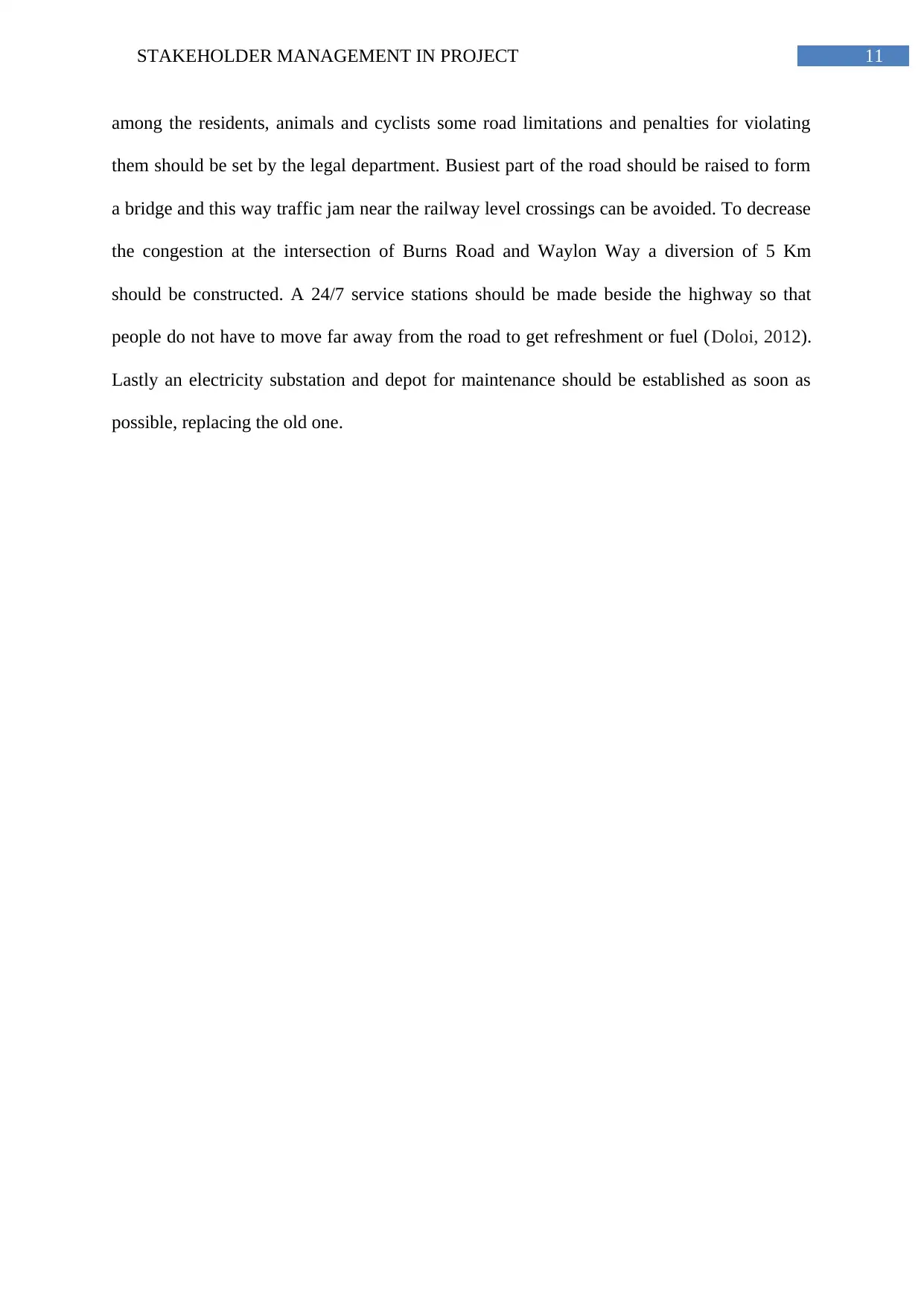
11STAKEHOLDER MANAGEMENT IN PROJECT
among the residents, animals and cyclists some road limitations and penalties for violating
them should be set by the legal department. Busiest part of the road should be raised to form
a bridge and this way traffic jam near the railway level crossings can be avoided. To decrease
the congestion at the intersection of Burns Road and Waylon Way a diversion of 5 Km
should be constructed. A 24/7 service stations should be made beside the highway so that
people do not have to move far away from the road to get refreshment or fuel (Doloi, 2012).
Lastly an electricity substation and depot for maintenance should be established as soon as
possible, replacing the old one.
among the residents, animals and cyclists some road limitations and penalties for violating
them should be set by the legal department. Busiest part of the road should be raised to form
a bridge and this way traffic jam near the railway level crossings can be avoided. To decrease
the congestion at the intersection of Burns Road and Waylon Way a diversion of 5 Km
should be constructed. A 24/7 service stations should be made beside the highway so that
people do not have to move far away from the road to get refreshment or fuel (Doloi, 2012).
Lastly an electricity substation and depot for maintenance should be established as soon as
possible, replacing the old one.
⊘ This is a preview!⊘
Do you want full access?
Subscribe today to unlock all pages.

Trusted by 1+ million students worldwide
1 out of 20
Your All-in-One AI-Powered Toolkit for Academic Success.
+13062052269
info@desklib.com
Available 24*7 on WhatsApp / Email
![[object Object]](/_next/static/media/star-bottom.7253800d.svg)
Unlock your academic potential
Copyright © 2020–2025 A2Z Services. All Rights Reserved. Developed and managed by ZUCOL.

